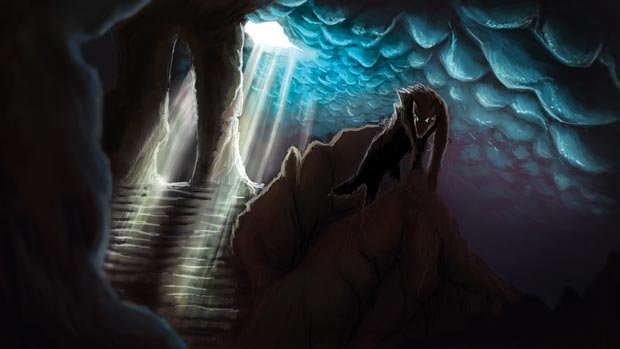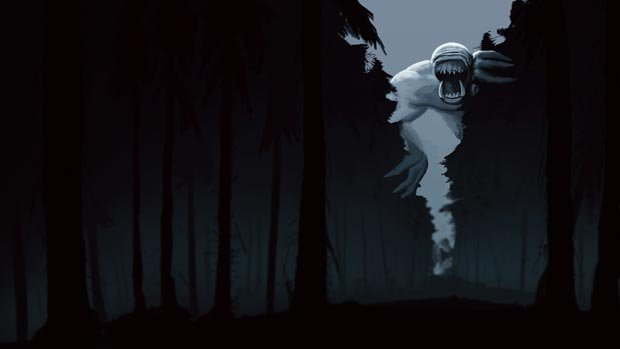How the creator of Ragnarok is exploring the challenges of stand-up horror VR

The formative experiments in modern VR gaming have established one rule of thumb: it’s much less disorienting to navigate a virtual world when your avatar is sitting down. Elite: Dangerous and EVE: Valkyrie ensconce you in a cockpit and thus avoid the disconnect between what your body is doing and what your eyes are seeing, but if Oculus Rift, Valve and HTC's Vive and Sony’s Project Morpheus are to succeed, they can’t be bound to flight sticks and steering wheels. Yet firstperson action games in VR raise questions: how will your brain handle motion when your body is certain it’s stationary? Should VR adventures be played sitting down? And if not, how do you avoid accidents when a player is mobile but effectively blinded in their own living room?
Ragnarok is a horror game based on Norse mythology in which players are hunted by fantastic creatures in a stark, snowy wilderness. At shows and onstage, creator Julie Heyde insists it be played standing up for immersion’s sake, but also as part of an ongoing experiment meant to better understand VR gaming.
“I would be sitting down and playing with the Rift, and it didn’t actually feel real, so I decided to do a stand-up VR game,” she says. “The first time [players] try Ragnarok with Rift, you see how much of a difference it is to them. When you just play it as a desktop game, there’s a snow giant coming towards you, and you get scared. But suddenly, when you’re in a 3D environment, you can’t get away, you’re scared and running for your life, and it’s a whole other experience.”
Heyde calls Ragnarok an active VR game. There are no stick-bound controls for turning, only for going forward (side-stepping is under consideration, pending motion-sickness experiments), so players must move on the spot to explore the space around them. At July’s Develop conference, one player during Heyde’s presentation began inching his way forward towards the edge of the stage, immersed in the VR space and unaware of the danger. It proved the point of Heyde’s talk: the challenge of developing a physical VR game without players getting injured.

“I like horror games. I like scaring people and I like getting scared myself,” Heyde says. “But it’s a whole other thing designing [horror] when you don’t want people to get so scared they actually fall over. Early on, when it was just the cave level, people were running around like crazy; they’d scream and so on. I’d just throw people straight in to the VR experience and they’d [be unsteady]. When I added the preceding level, the ice landscape of Jotunheim, it was a chance for people to find their feet.”
The first level acts as a tutorial, with a more open space and flatter path; Heyde found hills and bumps made players more inclined to move on the spot, and pursuits through tight caverns saw them moving by dangerous amounts. One player was so inclined towards drifting that Heyde was forced to grip him by the shoulders throughout the demo.
“People need to get used to VR at their own pace,” she explains. “Maybe when people are more [VR literate], we’ll be able to drop them in faster, but for now we need that open space they can take at their own pace before throwing them into the cave. People seem to be aware that there is still a physical space around them, but unless you introduce VR slowly, they tend to lean and tremble enough to be in danger.”
Weekly digests, tales from the communities you love, and more
The simple controls, very similar to Resident Evil’s classic ‘tank’ controls, have dramatically reduced incidents of motion sickness, Heyde says, at the expense of making escapes from pursuing giants more challenging and more terrifying. Like Resident Evil and Alone In The Dark, Heyde’s work feels like a prototype – the first steps towards something new.

The Ragnarok demo lasts 45 minutes, a long time in a VR space. “Standing up is physically demanding,” Heyde says, “but that’s why the game has to be active. Standing is hard, but so long as you’re moving – just on the spot – it’s much easier. The biggest thing I see after players have been immersed for that long is how hard it is to come back to reality.”
Oculus has an extensive list of best-practice guidelines for VR development, but creatives such as Heyde are just scratching the surface of what will and won’t work in the real world. With limited resources, their trials pale in comparison to the usability testing possible at Sony, Oculus and large studios, but in a way they are also freer to push at VR’s limits.
“Triple-A developers [are mostly] working with sit-down games, it seems,” Heyde says. “I guess it’s a liability issue as well as a design one, but I was so happy when I saw Sony’s Morpheus at GDC for the first time, and that you were actually standing up and playing it with two Move controllers. But then, of course, if you’re playing at home how do you make sure you don’t keep hitting people with your Move controllers? We have a lot of work to do.”
Edge magazine was launched in 1993 with a mission to dig deep into the inner workings of the international videogame industry, quickly building a reputation for next-level analysis, features, interviews and reviews that holds fast nearly 30 years on.



